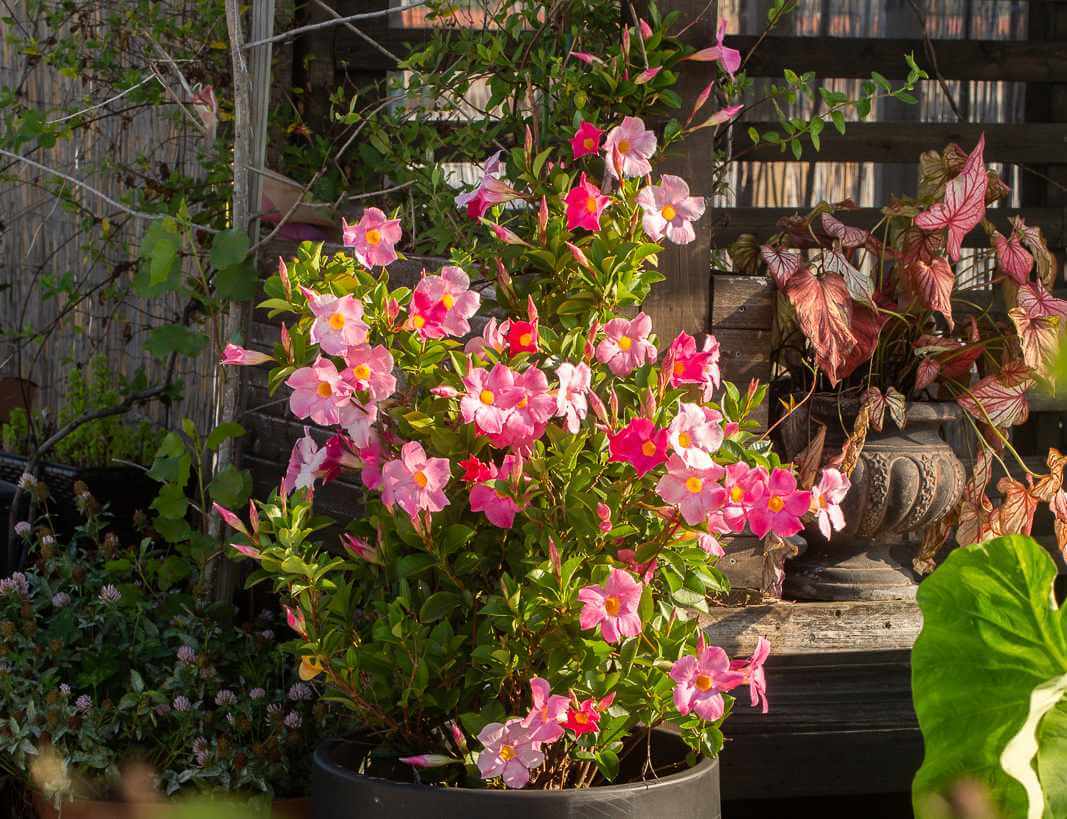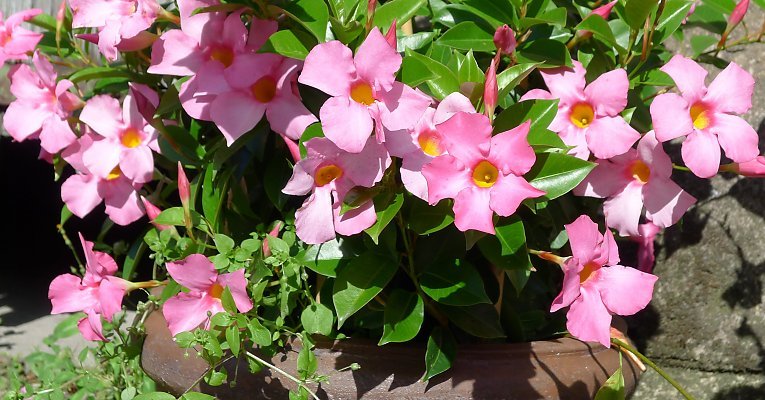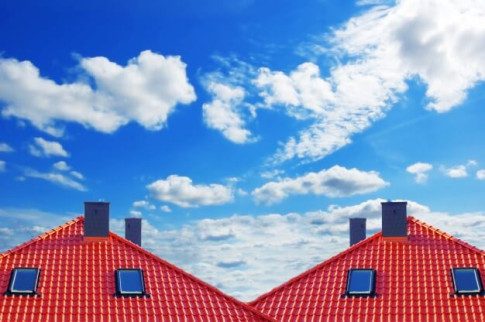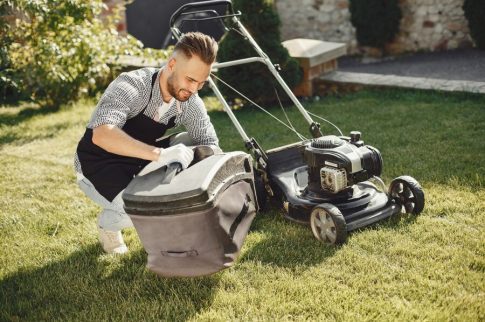What Is The Difference Between Dipladenia And Mandevilla – How To Grow Dipladenia?

Tropical plants are the weakness of many gardeners. Dipladenia grows better outside when the weather is warm. However, in cooler weather, it has to be brought inside. Mandevilla also requires the same temperature and soil to grow.
Despite that, both the plants are different from one another. So, if you have any of these, and you are confused about whether it is Mandevilla or Dipladenia, this article has got you covered.
You May Also like: How To Accomplish More On The Weekends – Essential Efficiency Hacks
Difference Between Dipladenia And Mandevilla
Both these plants are often confused because of the same color of flowers and the same shape. However, the Mandevilla plant grows as a vine. So, even if you try to grow in a pot, it will support a trellis to grow. On the other hand, the Dipladenia plant can grow in a pot, but it has a small bushy structure.
The foliage of leaves of both Dipladenia and Mandevilla are different. The leaves of Dipladenia are heart-shaped, glossy, bright green, and they are comparatively wider than the Mandevilla leaves. However, the Mandevilla leaves are narrower and more prolonged. In addition, the leaves of Mandevilla have a rough texture, while the Dipladenia leaves have a smooth surface and a thicker structure.
The flowers of both these plants may look the same at a glance. But, Mandevilla flowers are usually red. Although, it is possible to find Mandevilla flowers to be white, yellow, and pink, and they are larger than the Dipladenia flowers. The flowers of the Dipladenia plant are usually light pink and more petite in size, but like the Mandevilla, they can also be of white, red, and yellow colors.
Also Read: How to Choose Self-Help Books for Improving Interpersonal Skills
The Growing Guide Of Dipladenia

Although the growing guide of Dipladenia and Mandevilla are almost the same, there are a few differences. Dipladenia requires a warm temperature to grow from 65 degrees Fahrenheit to 70 degrees Fahrenheit during nighttime.
During summer, you must water the plant frequently. It can grow beautifully in the pot or on the ground. However, before you water it frequently, check if the top of the soil is dry or not. If it is not dry, wait for it to become dehydrated, and then water it the next time. The sunlight must be indirect, so it is better to put the plant in a well-lit place.
If you want to grow a Mandevilla plant, you must put a trellis on the pot to support the growth, but in Dipladenia, there is no such requirement. Whereas in Mandevilla, the trellis has to be there all the time, even if the plant is big enough.
A portion of liquid plant food is good to fertilize the Dipladenia plant. You should fertilize the plant at least in 3-4 weeks. But, during the winter season, it does not need fertilization. During cold, freezing winter, you should bring the Dipladenia plant inside the house because it requires a warm temperature.
However, if you have planted the Dipladenia on the ground, you can’t possibly bring it inside during winter. Instead, you can cut the plant almost to the ground and cover it with a pot to protect it from the winter breeze. In that way, it will grow again when the fall comes.
How long Does A Dipladenia Plant Live?
The best way to flourish the growth of a Dipladenia plant is to grow it in a pot with bottom drainage holes. Otherwise, the soil may be too much hydrated, and won’t give the roots too much space to grow. It does not require much maintenance like the Mandevilla plant, and it is moderately tolerant to drought.
The most difficult part when growing a Dipladenia can be about the sunlight. It cannot tolerate direct sunlight but the place, where it grows must be well-lit. So, if you plan to grow it as a houseplant, it’s better to put the pot near a south-facing window so that it keeps on getting the light, but not too much of it directly though.
If you stay in a colder area, your Dipladenia plant will likely suffer during the winter. So, you can cover it with a pot, or bring it to the greenhouse, and cover the roof with straws to protect it from the unintentional winter breeze. If you still notice some of the branches are dead, wait till the spring hits to trim them off.
How Do I Grow My Dipladenia Plant Back If It Seems Dead Suddenly?
Some people have complained that despite taking all the precautions they suddenly notice their Dipladeni plant is losing all the leaves and is turning yellow. In that case, the most probable consideration would be that you have either overwatered the plant or under-watered it. It may also happen if the fertilizer is not right for the plant.
You should fertilize the plant every 2 weeks in such circumstances. Make sure the plant stays at a temperature of 60-65 degrees Fahrenheit during the night and above 70 degrees during the daytime. The solid outside, or inside the pot must be well-drained, and sandy with extra hummus.
Also, look for pests before bringing them inside for winter. If you notice any insect, or their eggs beneath the leaf axils, it may be the reason why your plant has died suddenly. Remove the dead leaves by hand, and use an insecticide to spray on the plant. It will be better if you again plant a trellis, or stake to support the growth because it will again grow from the ground.
Conclusion
The summer and winter care for both Dipladenia, and Mandevilla plants are the same. Both the plants also have the same growing requirements too. In such cases, it will be better to follow the exact maintenance instruction for Mandevilla as you have followed for the Dipladenia plant. You only have to remove the stake when the Dipladenia plant grows a little, but for the Mandevilla plant, the stake will always have to be there.
FAQs
1: Is It Okay To Trim The Tendrils Of The Dipladenia Plant?
Ans: Yes, it is okay to do so. You can cut the tendrils, and pinch off the gangly growth of the plant regularly even if you want to. If they attach to the blinds too frequently, trimming them is a good solution.
2: What Are The Common Insects That Attack A Dipladenia Plant?
Ans: Mealybugs, whiteflies, spider mites, and scale insects can hamper the Dipladenia plant. They can be white, or dark brown in color. You may spray water, or mild insecticide to get rid of those.
3: How Do I Retain The Bushy Structure Of My Dipladenia?
Ans: Remove the wilted flowers regularly so that new buds can blossom. During repotting, it is better to prune the plant when the spring hits. Thus, the plant will maintain a bushy structure.
Read More,
























